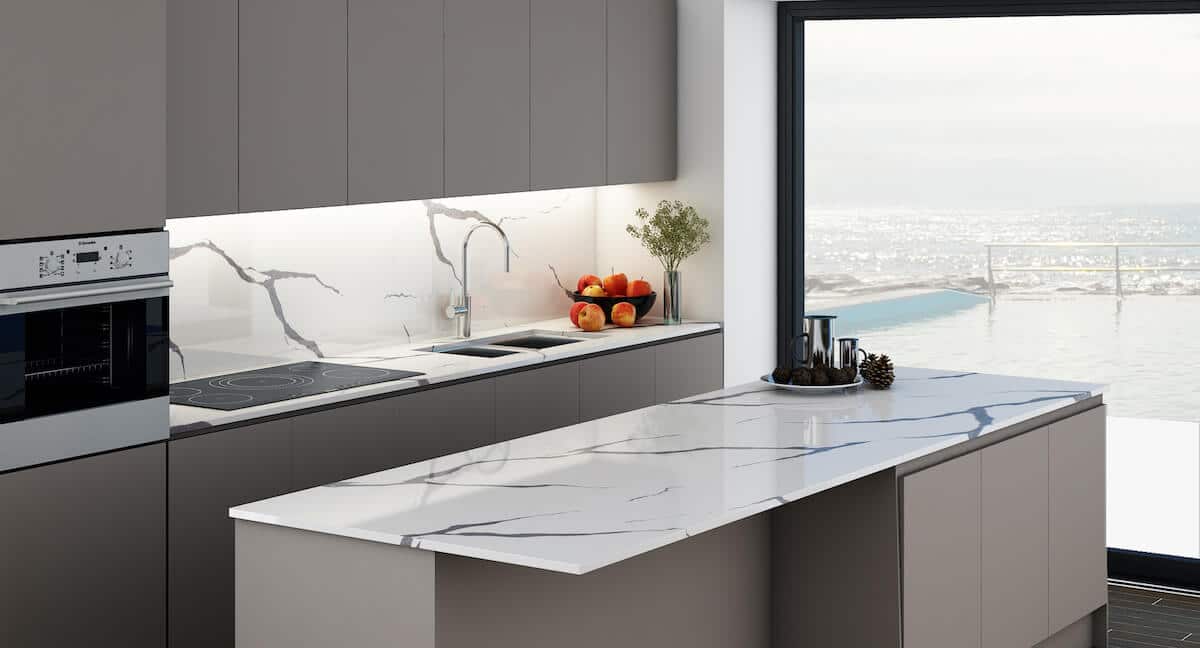
If you’re looking to upgrade your home, specifically your kitchen countertops, finding the perfect time can be a bit challenging. You want to make sure that your countertops are done right the first time and up to your standards. You also want to be sure you’re getting the best pricing available. Since price typically fluctuates throughout the year, it’s important to research the best time to upgrade for the highest savings. Today in our feature kitchen article of the week, we’re going over just that!
If you’re looking to upgrade your countertops after the holiday season, or are potentially treating yourself to this as a holiday gift, February and March are a great time to do so.
Usually, during this time, the busier season for both kitchen remodeling companies and yourself is over. You’ve gotten through the holidays and have settled into your new routine by now. Which means you should have a better understanding of your schedule.
With the busy holiday season over, products tend to go down in pricing and be more readily available.
Depending on when you decide to embark on your new upgrade, products and materials may either be out of stock, back-ordered or currently shipping. This tends to happen in late fall and early winter, due to many people wanting to complete remodels before the holidays. Eliminate any of these issues by getting your countertops done in the earlier months of the year.
The springtime is another great time to utilize your tax return money to upgrade your countertops.
An April upgrade will have given you enough time to get your taxes done and get your return back. Investing that money in your home can result in a great return on investment. Not only do new countertops increase your home’s value, but they also give your home a whole new look. Which many people crave with spring cleaning.
Also, upgrading your countertops in May gives you plenty of time before back to school season, which can be hectic for many families. We recommend upgrading in May because you’ll likely even finish your remodel before July, giving you ample time to enjoy your new kitchen during the summer!
Summer tends to be a very popular time where people decide to upgrade and replace their kitchen countertops. During the summer, kids are out of school, and life usually slows down just a bit. Which makes it no surprise that many families decide to upgrade during this time.
It’s a great option because you can easily grill outdoors and stay out of your kitchen for a few days! Which isn’t typically possible during the colder winter months. Here in Gainesville, the summers are gorgeous. Plus, enjoying a little bit of time outdoors is a wonderful way to spend time with your family and relax. Plus, by the time school starts your kitchen and countertop installation should be . So you can start enjoying your new space come the new season!
Perhaps you’re going to host Thanksgiving or Christmas and you want your home to be looking its best. Since this is such a popular reason for remodeling, the earlier you get this done the better. While September may seem early, we recommend that you start this process right away. Many times, there is an increase in demand which can lead to longer lead times, so the earlier the better. No one has ever complained about their kitchen upgrade being early, but if it’s late, that’s usually a different story.
With a September remodel, you’ll have several months to complete your countertop upgrade. Plus, finish many other updates you prefer before any holiday festivities begin! Don’t worry though if you have to start later than September. With the right company, your remodel will be complete timely, and efficiently! Connect with us directly if you’re needing to get your kitchen countertops upgraded for the holiday season.
No matter when you decide to upgrade your home, Jackson Stoneworks will be here for you! When it comes to kitchen countertop upgrades, Jackson Stoneworks has been in the industry for years and can help make the kitchen design and installation process easier, especially when it comes to countertops. We offer in-home consultations and carry a wide variety of materials including quartz, granite, porcelain, and marble countertops. Connect with us today for more information!
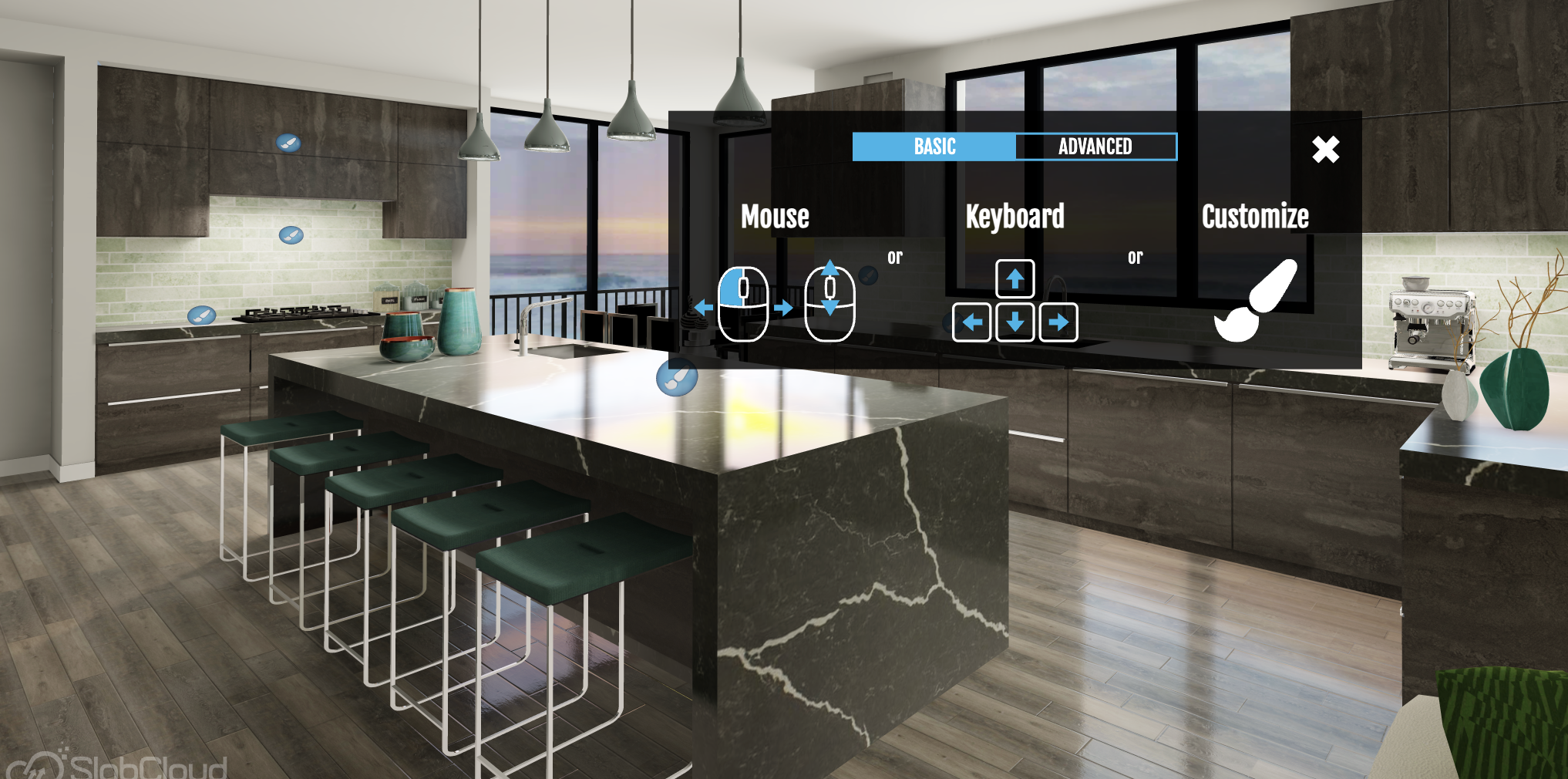
A good kitchen not only looks nice but also works well. You want to see different stone options on different countertop styles. This increases your possibilities and, thus, makes your time at Jackson Stoneworks more enjoyable.
Our online kitchen design platform can help you ensure your new kitchen will be very efficient and comfortable to use. Our platform’s tips and tricks can allow you to accomplish a lot with the space you have.
Upgrading your kitchen can be a long process. If you visit one of our in-house sales teams with no idea what you’re looking for, it can become even longer. You need to spend additional time on consultations, waiting for designs, and making more countertop color sections.
Luckily, you can significantly cut down on this time frame if you’re using our kitchen visualizer online. You can begin the design process quickly and easily. It’s straightforward to make changes since there is no middleman, making it so that everything can be done on your schedule.
Since a kitchen layout visualizer can allow you to see many options simultaneously, it makes researching and choosing a final design a lot easier. You can also tweak your design quickly until it’s completed and ready for our in-house sales team.
During the research process, you may develop an idea but have no idea if it’s even a possibility. With our online visualizer, you can quickly try out a countertop color choice and see if it will work. This can help you narrow down ideas quickly and easily.
You can also figure out the dimensions and find out how much space is available for other items in your dream kitchen. Knowing this can help you research and budget for stone material and any other features you may want in your new kitchen.
One of the biggest benefits of using an online kitchen design platform is accessibility and ease. You don’t need to make an appointment with a designer. All you need is a desktop computer or laptop.
The software can walk you through instructions to build your room’s foundation, including wall and window placement. It can even guide you based on where cabinets can or cannot be physically placed.
There isn’t a huge learning curve when it comes to using most software. The program takes care of the technical aspects so you can focus on simply designing a kitchen that meets your needs. This makes it accessible to everyone, even if you aren’t an expert with computers.
Designing your new kitchen doesn’t have to be a difficult experience. Our online kitchen visualizer can help you easily plan kitchen upgrades to meet your needs best. Plus, you’ll save money and time while having a lot of flexibility along the way.
Get started on designing your new kitchen with KitchenWhiz today!
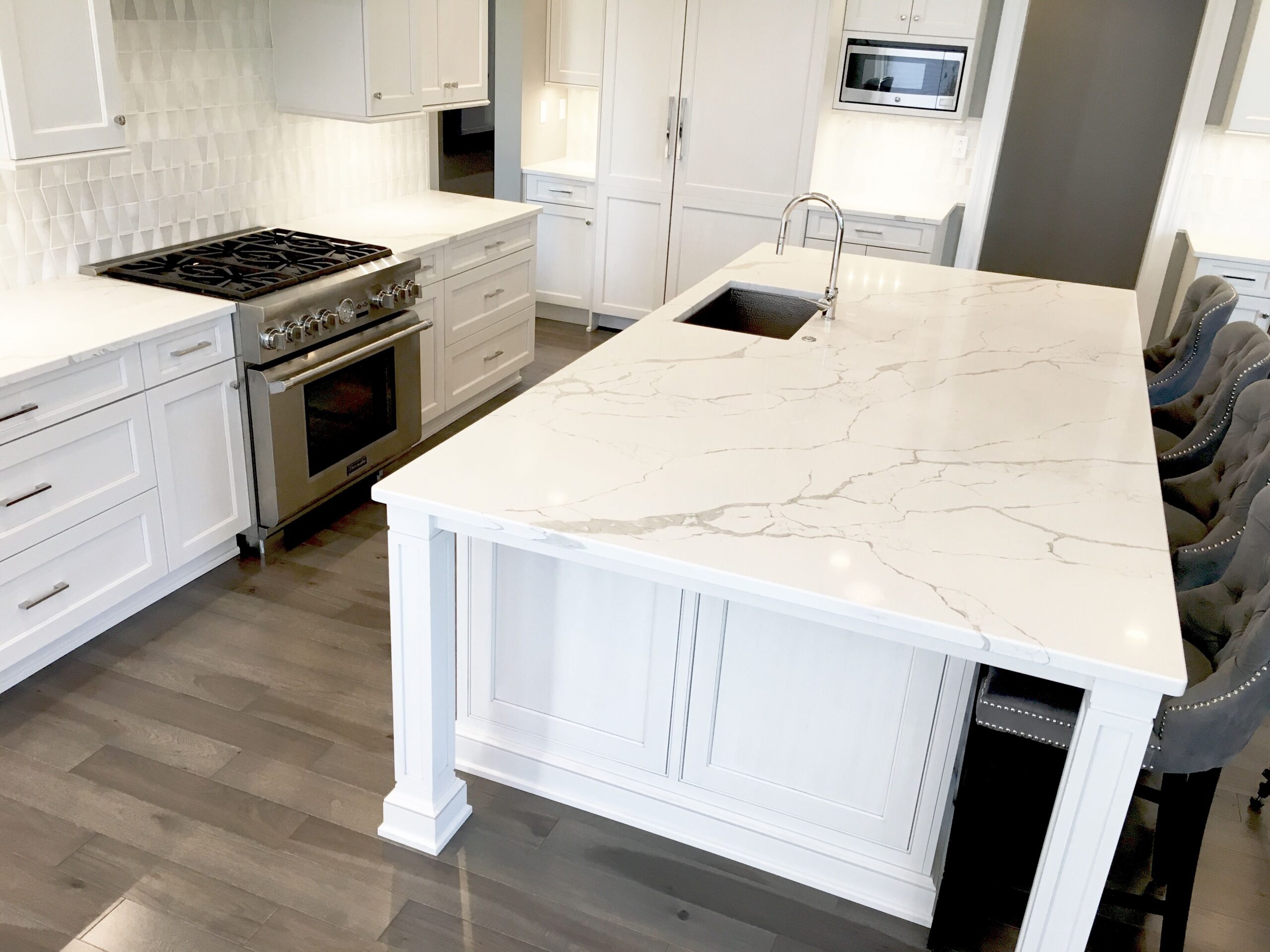
Do you want to increase your home’s value? Then upgrading your countertops is the easiest way to go about it. After all, kitchens are the main selling points for houses.
A spacious kitchen will win anybody’s heart. Second to space is cabinetry and countertop design.
If you are going to upgrade your cabinets, then you might as well consider the countertop. Most of the time, cabinet upgrades are more expensive.
A new countertop will compliment your kitchen space. In addition to that, it’s also an investment that will last well into the future.
Even the most beautiful kitchen will feel old after a couple of years.
As mentioned earlier, cabinet upgrades are more expensive than kitchen countertop upgrades. Nevertheless, one can argue that countertops have more impact on the kitchen’s overall beauty.
Most of the time, a well-placed countertop is the focal point of any kitchen. A change in stone will liven your kitchen and give it a new glow.
Nonetheless, be careful when upgrading your kitchen countertop. The wrong choice of stone color and type can easily mess up your kitchen’s design.
It’s one of the reasons why quartz and granite are the best stones for kitchen countertops. Quartz comes in so many varieties and colors—It can emulate any natural stone without sacrificing quality. On the other hand, granite is a beautiful and insanely durable natural stone.
Check this website out for more on quartz countertops.
Nothing lasts forever.
Is your countertop chipped, scratched, or massively stained? Then it’s time for a countertop upgrade.
Sure, you can always try and repair your countertop. However, that’s an unpopular route (especially if the damage or stain is extensive).
We know countertop upgrades are heavy investments. Nevertheless, they are futureproofing.
While you are at it, why don’t you try quartz countertops?
In addition to that, quartz is almost non-porous (Its water absorption rate is similar to that of porcelain tile). You’ll never have to worry about germs or bacterial infestation—With quartz countertops, you don’t need sealants.
Maintenance is a big deal, especially for kitchen and bathroom countertops.
There are so many countertop materials you can try out. Few examples include concrete, marble, granite, porelain, quartz, and even wood, among many others.
I think we all agree that from the list above, wood is the hardest to maintain.
For peace of mind, you need countertops that are easy to maintain. Countertop anxiety is the last thing you’d want.
From the list, engineered stone aka, quartz, is the easiest to maintain. It doesn’t even require a sealant. Just make sure you wipe off all the stains with a soapy piece of cloth.
Do you want to add a new kitchen sink?
Are you thinking of having a double sink in your master bathroom?
All these new features and fixtures demand countertop upgrades. In such cases, you’ll need water-resistant countertops.
Also, there are still many other features to add to your kitchen. Those features will require you to bring in new countertop materials with specific properties.
Some of the countertop materials available in the market are no fun at all. For example, some (like travertine) are vulnerable to water.
Others are vulnerable to heat. Therefore, you have to be very careful with hot utensils. It’s difficult working with such countertop surfaces, and you’ll always have to walk on eggshells to avoid damage.
Nevertheless, thanks to technological advancements, we now have durable countertop materials. Upgrade your countertop today for a better cooking experience.
Are you convinced that it’s now time to upgrade your kitchen and bathroom countertops? Continue reading to discover the most important factors to consider when upgrading your countertops.
Price is perhaps the most crucial factor to consider when upgrading your countertops. However, I’m not advising you to go for the cheapest countertop design you can find in the market. Always stick to your budget.
Sure, I know they are among the most expensive countertop materials. Nevertheless, you’ll get the best value for money.
Looks are second to price. It’s better to have a decent-looking but durable countertop than a luxurious-looking but fragile countertop.
Nevertheless, be careful when choosing the best countertop design and colour for your kitchen or bathroom.
The countertop should complement the room. I advise you to see and touch the countertop in person before you fill in your payment details—It’s one of the many reasons I’ll always vouch for sellers who send samples.
Each countertop material has its appeal.
For example, marble has a stunning appearance complemented by its smooth texture. Granite is handsome with a hint of toughness and roughness. On the other hand, quartz is unpredictable because of the many patterns and designs.
Get a kitchen or bathroom countertop that will carry you for years. After all, it’s not every day you redesign your kitchen or bathroom. Get countertops that will give you peace of mind.
Once again, granite and quartz are at the top of the food chain because of their stain-resistance. To maintain these countertops, all you’ll need is a piece of soapy cloth.
In addition to that, they are also the cleanest (Especially quartz). Quartz has a very low affinity for water, bacteria, and stains.
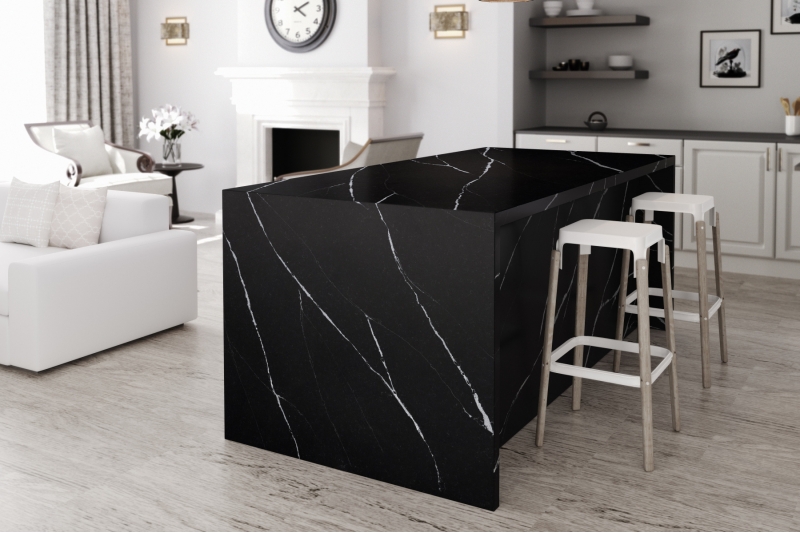
Choosing the best countertop for your kitchen can be a challenge. There are various options to think of, such as granite, marble, and quartz. Silestone is another excellent choice. There are many benefits to Silestone Quartz Countertops. It is made up of natural quartz crystals plus other materials, such as polyester resin that glues the quartz crystals together. Silestone also possesses antimicrobial and color agents. At Jackson Stoneworks, we offer Silestone Quartz countertops for both kitchen and bathroom applications.
Silestone is made of quartz—one of the hardest natural materials—and other extremely durable raw materials, making it extremely durable. However, apart from its exceptional durability, what makes it a great choice for a countertop
Some of the key benefits of silestone quartz countertops include:
Since silestone is a non-porous surface, it is highly resistant to staining from liquids such as coffee, olive oil, lemon juice, vinegar, and other common products that can stain surfaces. The material’s stain-resistant properties also help keep it free from infiltration by bacteria.
The superb durability of silestone quartz makes it scratch resistant. This quality can help preserve the brand-new quality of your countertop for several years after its installation.
Silestone countertops possess excellent resistance against cracking from common impacts that occur when cookware is dropped on surfaces.
Since silestone quartz is non-porous, it is also a low-maintenance material. You can clean up spills with a non-abrasive cleaner and soft cloth. Silestone quartz does not require resealing as do some other countertop materials.
Of course, no countertop is completely invulnerable, which is why it’d be a good idea to know how to care for a Silestone countertop. Here are some basic tips
RECAP
Silestone quartz countertops add a unique elegance to kitchen spaces. These countertops are often offered in various textures and patterns to create the desired appearance.
It is important to use the services of an experienced professional silestone quartz installer. Although this material is durable, it may be damaged if the installation work is not done properly.
For information about the silestone quartz countertops we offer at Jackson Stoneworks, give us a call today at 352.372.6600 or leave us a message through our contact form.
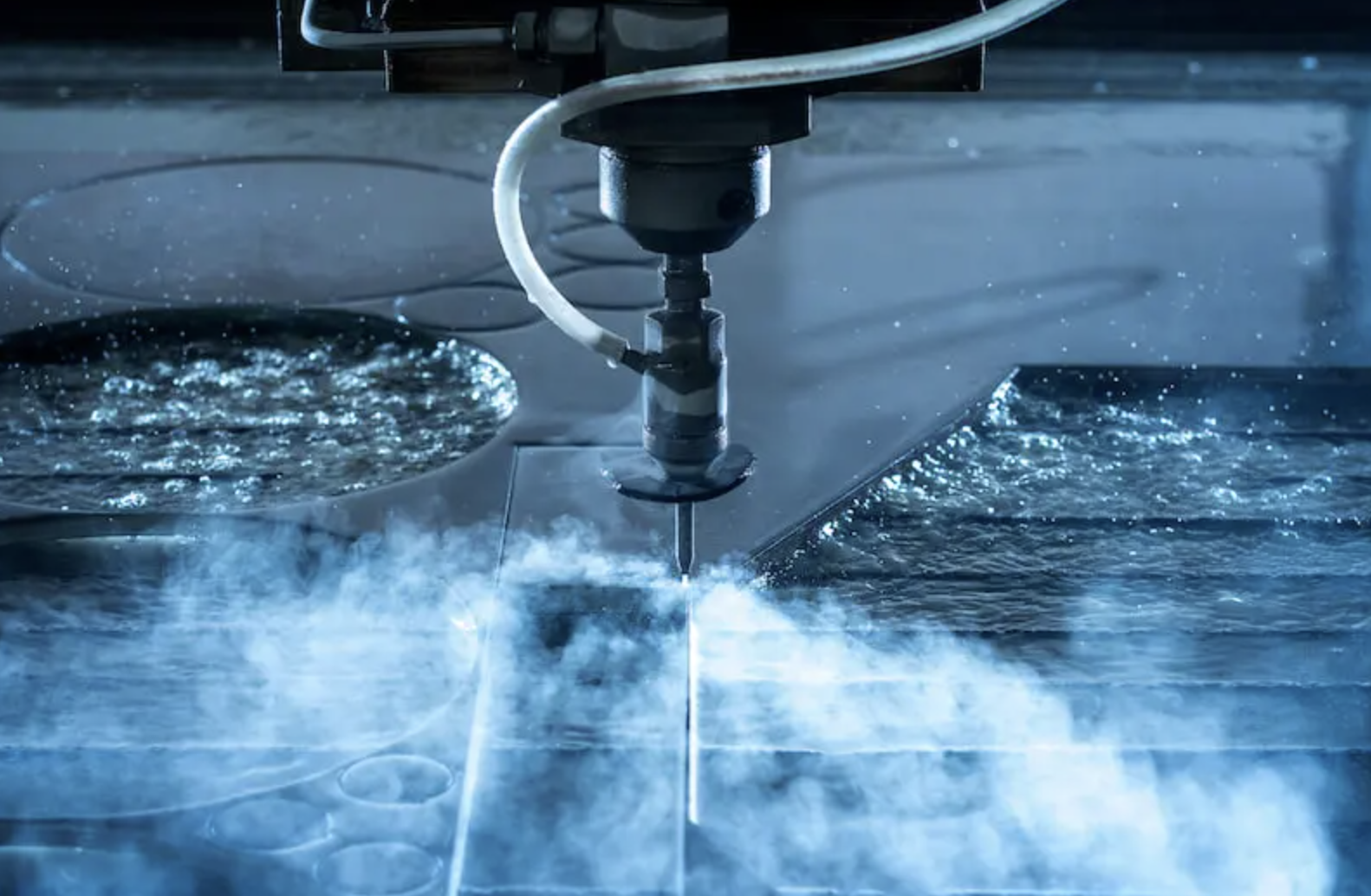
Waterjet cutting is a mechanical process where the material is removed by physical contact and material wear. The main difference with other cutting processes is the fact that it’s a cold-cutting process (non-thermal), meaning that no heat is used in the cutting process.
In today’s world, all manufacturing processes have to meet three main objectives: increase production, reduce waste and improve quality. Processes such as 3D printing, sheet forming, injection molding, laser and plasma cutting try to achieve these goals at reduced cost and production times while increasing efficiency and sustainability at the same time.
Every one of those processes has its place in the manufacturing industry due to various benefits and limitations. Modern waterjet cutters have also incorporated CNC technology into their design to meet these goals with even better results.
In this article, we shall take a deeper look into the advanced process of waterjet cutting.
Waterjet cutting uses a high-pressure stream of water mixed with an abrasive material to cut a wide range of materials.
A high-pressure water pump pressurizes the water. This water flows through high-pressure tubing into the cutting head. In the cutting head, the water flows through a nozzle, turning it into an extremely fine stream. This stream cuts whatever material is placed in front of it.
A waterjet cutting machine can produce pressures as high as 100,000 psi or about 6900 bars. To put it into perspective, fire hoses generally deliver pressures between 8 to 20 bars. The waterjet nozzle is assisted by a vision system to facilitate the precise and efficient cutting of the part.
It is easy to manipulate the nozzle to accommodate the cutting of different materials. Depending on whether an abrasive substance is used or not, there are two types of waterjet cutting methods:
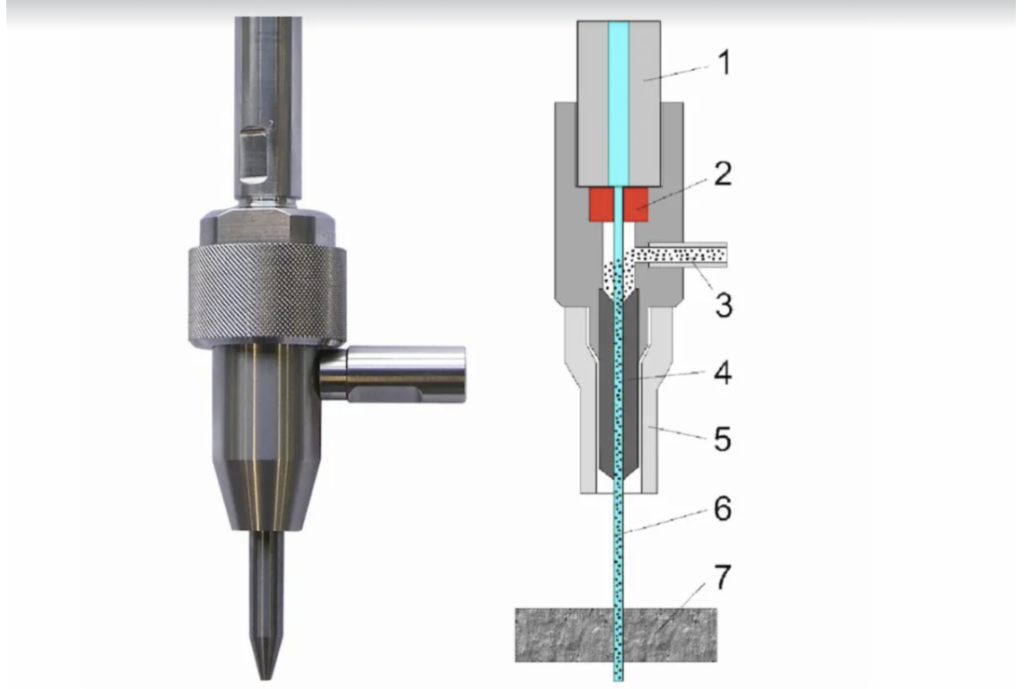
1. high-pressure water inlet; 2. jewel (ruby or diamond); 3. abrasive inlet; 4. mixing tube; 5. guard; 6. cutting water jet; 7. cut material
When cutting harder materials, abrasive agents are mixed with the water. This occurs in a mixing chamber located in the cutting head just before the abrasive jet exits the system.
Popular agents for abrasive waterjet cutting are suspended grit, garnet and aluminum oxide. As the material thickness/hardness increases, so should the hardness of the abrasives in use.
With the right abrasives, various material types can be cut. Common materials cut with abrasives are ceramics, metals, stones and thick plastics. There are, however, certain exceptions such as tempered glass and diamonds that cannot be cut with abrasive water. Tempered glass shatters when cut with a water jet.
Water jet cutters also work without the addition of abrasives, mainly to cut soft materials. A waterjet cutter designed only for this purpose does not have a mixing chamber or a nozzle. A high-pressure pump forces pressurized water out of an orifice to create precise cuts on the workpiece. Although most industrial cutting devices using waterjet technology enable the use of both methods.
Pure waterjet cutting process is less invasive compared to abrasive waterjet cutting. The jet stream is also exceptionally fine and does not impart any additional pressure on the workpiece.
Pure waterjet cutting is ideal for softer materials like foam, felt, wood, rubber, food and thin plastics.
Waterjet cutting provides certain benefits that make it an excellent choice for general as well as very specific applications. Some of the benefits are as follows:
Waterjet cutting is known for providing high cutting accuracy. Waterjet cut parts are of very high quality even when limited by tight specifications.
A water jet cutting machine can work with tolerances up to 0.025 mm (0.001 inches) but tolerances between 0.075 to 0.125 mm are more common for parts less than one inch in thickness.
The tolerances may increase with thicker materials depending on the technology. The accuracy depends on factors such as table stability, machine construction, abrasive flow rate, cutting stream control, stream lag, and process error.
The heat-affected zone (HAZ) is a byproduct of most hot-cutting processes. In processes such as laser cutting and EDM, the zone around the cut edge does not melt during machining but undergoes a change in its properties.
Discoloration, heat distortion and hardened edges can all affect the characteristics of the final part. These parts require heat treatment before being put into use.
Being a cold-cutting process, waterjet cutting does not create heat-affected zones. This gives the final parts superior edge quality and more dependable properties without imparting any stress to the part.
The use of water jet cutting thus diminishes the need to worry about imperfect cuts, weak points and warping. Manufacturers can also use pre-heat treated parts to bring down production costs.
Being a non-thermal cutting process also means that there is no slag formation and dross waste created.
Waterjet cutting delivers superior quality parts that no other cutting method can compete with. The edges are smooth and do not need deburring.
The final quality depends on several factors such as cutting speed, pressure, abrasive flow rate, and nozzle size. The process parameters may need to be modified for optimum output.
A waterjet cutter does not use any cutting tools and the nozzle does not need to be changed to accommodate different materials and thicknesses. The same nozzle is used for different applications by adjusting the cutting stream parameters, such as feed rate to achieve the appropriate cutting speed.
Since a tool change is not required between materials, the water jet cutting machine can cut different materials one after the other which improves the operational efficiency by saving time and tool costs.
Waterjet cutting is more cost-effective compared to alternative cutting methods in many applications, especially in the food industry. The process does not always need fixtures, jigs or clamps which increases the production speed.
Another benefit that this process offers is the possibility to stack and cut several layers of material all in one pass. Stacking can also be performed for dissimilar materials which makes this a simple yet effective way of increasing part production.
Cut parts also don’t require any post-processing which reduces the overall cost. The process also creates minimal material waste.
As explained before, the waterjet cutting process is not limited by the type of material. It can cut a wide range of materials as long as the correct process parameters and abrasives are selected. We shall cover this topic in detail further in the article.
In this day and age, sustainability is an important factor when selecting a manufacturing process. The waterjet-cutting process checks all the right boxes when it comes to sustainability. It has amazing advantages such as no slag formation, no dross waste, and no need for heated parts. It also does not create any toxic fumes or greenhouse gases.
The finished parts also do not require any post-processing tasks such as heat treatment. The main cutting medium of water is also recyclable which reduces the impact on the environment. In addition, no cooling oils or lubricants are required as the water jet itself acts as a coolant.
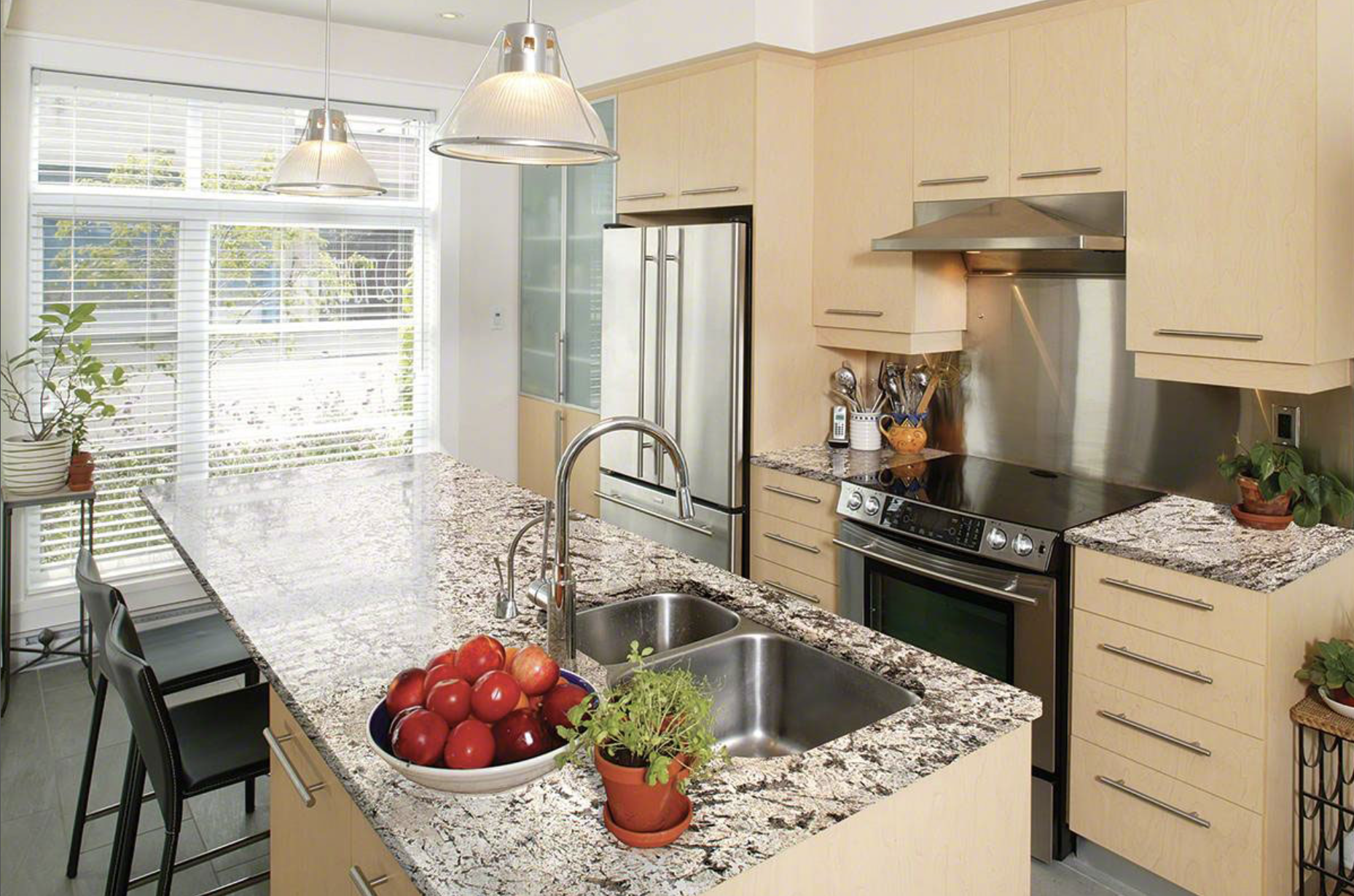
Granite is one of the best building materials for new countertops. There are many reasons that is the case, as well as many different areas of the home where you can implement granite countertops. However, there is no area of the home more suitable for installing granite countertops than the kitchen. Having granite kitchen countertops will not only look good but will offer helpful functional benefits as well. Choosing the right material for your kitchen countertops in no small task. Selecting granite can be one of the best decisions that you ever make.
There are several factors to consider when thinking about buying granite kitchen countertops, such as what type of granite you like and the functionality of the different types, among many other aspects.
No matter which type of granite you decide on, there are certain characteristics that are generally similar for all types of granite.
Different types of granite can either feature veins, swirls or be consistent in pattern.
Regardless of which type you select, granite is known for being one of the most durable countertop materials that you will be able to find. The durability of the stone makes it perfect for use in the kitchen. Generally speaking, between cooking and spending time with family, your kitchen will see a lot of use. Because of this, you want to make sure that you have kitchen countertops that both look good and can handle the pressures of frequent use. Granite countertops check both of these boxes.
Granite comes in a multitude of styles and colors, meaning that you are virtually assured to find at least one type that suits your taste.
When it comes to granite, there are various pros and cons that you should consider before purchasing. Both the pros and cons of owning granite are explained below.
| Natural stone look |
| Many types to choose from |
| Durable |
| Heat resistant |
| High resale value |
One of granite’s major benefits is the look of natural stone. There is no denying that certain patterns that occur in nature are simply amazing. Granite has plenty of these patterns that you can choose from.
Granite will offer you a seemingly endless amount of options to choose from. Marble.com has well over 500 variations the company offers.
Granite is one of the most durable natural stone materials that you will be able to find. As long as you take proper care of your granite, it will last for many years – so many that it will likely reside in your home for more years than you do.
A huge advantage that granite offers in the kitchen is that it is heat resistant. Granite will be able to handle any hot kitchen items that you set down on the surface.
When it comes time to sell your house, there are few more attractive features in a house than natural stone countertops – especially in the kitchen. Granite’s durability and heat resistance make it that much more attractive to perspective buyers as well.
| Rare granite will cost more |
| Heavy objects can cause damage |
| Needs to be re-sealed yearly |
Much like any stone, the rarer the granite you choose, the more you will have to pay. Some rare forms of granite can cost around $200 per square foot, so make sure that it is really what you want before buying it.
While it is one of the most durable natural stones that you can find, granite is not totally indestructible. You will need to be very careful when handling any heavy items around your granite countertop. If you drop those items, especially on the countertop’s corners, you can cause significant damage.
Your granite countertop will need to be re-sealed roughly once every year. Despite this seeming like an inconvenience, the process of re-sealing your granite countertops is relatively simple and quick. Something else to keep in mind is that granite does not need to be re-sealed as often as some other countertop materials, such as marble, do.
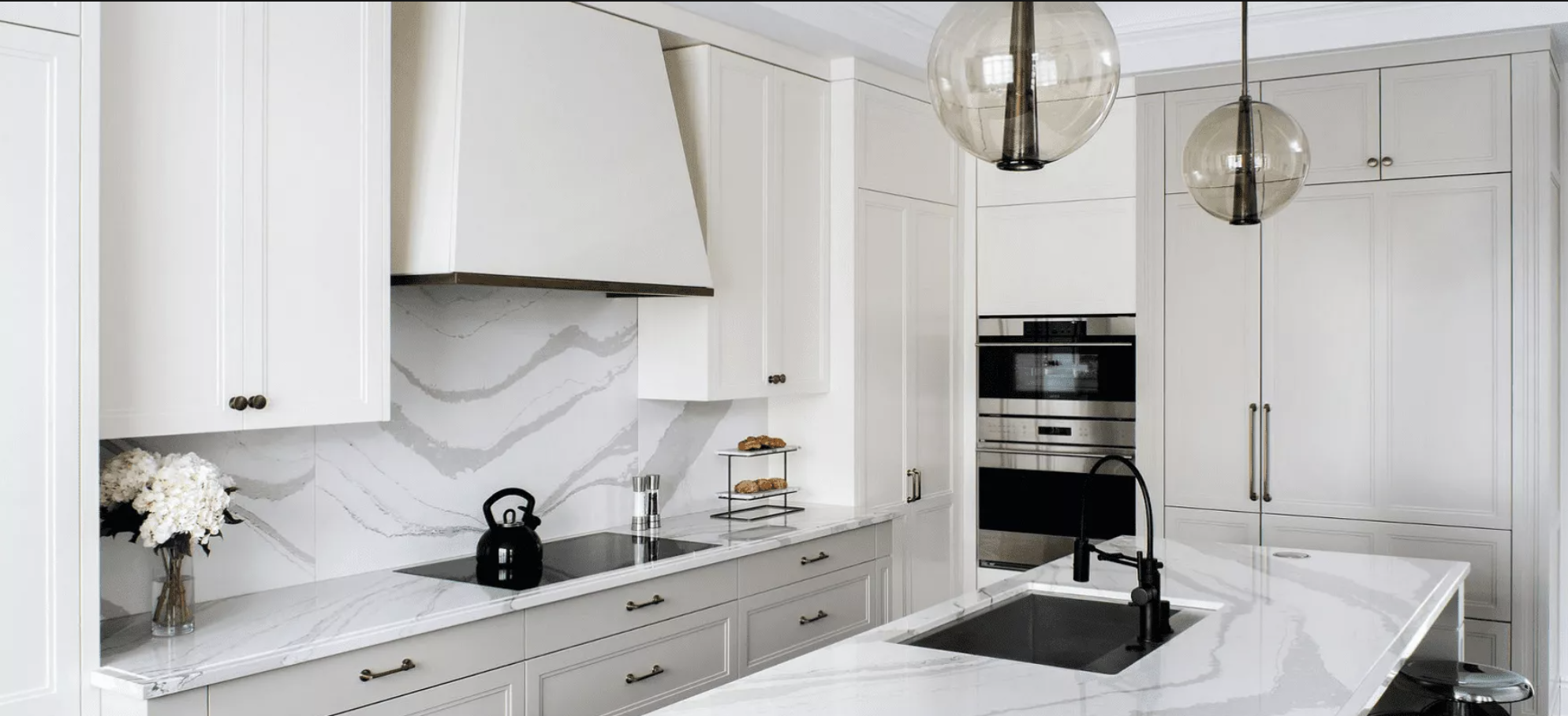
There is a wide range of countertop choices out there on the market. When it comes to building materials and home projects, we tend to focus on all-natural solutions. There are some cases, however, where man-made synthetic materials are better than natural.
For those who want something a bit more exotic than standard granite, marble, or stone countertops, there is Cambria. What is Cambria Quartz, you might ask? Well, it’s one of the hottest trending premium countertop materials. For more about this luxurious brand of quartz countertops, keep reading.
Cambria Quartz is an American-Made, Family-Owned Brand of Quartz Countertops based out of Minnesota. Cambria Quartz Slabs are made up of 93% Crushed Quartz, and 7% pigment and binder. Cambria Quartz never needs to be sealed, unlike granite. Cambria Quartz is also scratch-resistant and stain-resistant. Cambria Quartz is sold exclusively through Cambria Approved Premier Dealers, with Select Few Designs also being offered at the Home Depot.
In addition to this, every Professionally Installed Cambria Quartz Countertop Project also carries a Lifetime Warranty against manufacturing defects. You can Buy Cambria Quartz Countertops with Confidence, knowing The Company Fully Stands Behind its Product.
Cambria Quartz is:
Cambria Quartz is manufactured in Le Sueur, Minnesota at their Flagship Processing & Manufacturing Center. Cambria Quartz is made using Breton stone Technology, a process that many different quartz manufacturers employ to create the finest quartz slabs known to man.
The process of how Cambria Quartz is made starts at Cambria’s Proprietary Quartz quarry, where Pure White Quartz is mined from the Earth. The quarried pieces of Quartz then make their way to Cambria’s Manufacturing Facility. Next, Cambria Quality Control Technicians sort the quartz into varying shades of white, choosing only the highest quality and pure white pieces for their slabs. These hand-selected pieces of quartz are then ground down into varying sizes, from Lima Bean-sized chunks, all the way down to Sand.
Once this is complete, the varying degrees of quartz pieces are aggregated together using the Breton stone technology as mentioned above. Binder is added to the mixture, while air is simultaneously vacuumed out of the mixture through vibration. After all the air has been vacuumed out, the slabs are then pressed into the desired slab sizes and baked at high heat. This is what creates Cambria Quartz Slabs that are denser than traditional Granite Slabs, while also being Non-Porous.
How Much Does Cambria Quartz Cost?
Quartz Countertops range in price and Everyone always wants to know, is Cambria Quartz expensive? Calculating the Cost of Quartz Countertops is hard to do on your own. Pricing is different from Fabricator to Fabricator depending on the level of work the company can produce. More skilled Fabricators may charge more for their work or may offer more intricate cutting options, like a mitered edge or waterfall panels. On Average, you can expect to see Cambria Quartz prices between $90-150/sf. Locking down an exact price varies on a couple of factors:
Traditionally if you wanted a white countertop, you had to use Marble. However, Marble Countertops are Expensive and need frequent maintenance to keep them pristine. Quartz Countertops are the next best thing, with Cambria Quartz that looks like Marble. A lot of people like the Quartz Countertop designs that look like Marble because you can get the Marble “look”, but with all the benefits of Cambria Quartz Countertops.
When you choose a Cambria Quartz Countertop that looks like Marble, you get the look you desire, but none of the drawbacks of actual Marble. Have peace of mind knowing your Marble-looking Cambria Quartz Countertops will never stain or degrade over time as Natural Marble Countertops will.
By Far Cambria’s most popular designs, blend a solid three-color profile in natural tones. These colors resemble a river of flowing energy over the landscape. This is the perfect opportunity to add some movement to your kitchen.
We recommend any of the Brittanicca designs for anyone looking for a more classic marble look but with a slight twist. Goes great with rustic or luxe kitchen designs.
Skara Brae Cambria Quartz is a great Marble Alternative and is very popular. With Similar Veining and Patterning to the Brittanicca Quartz Colors, Skara Brae’s taupe-gray bold veining adds a pop of depth and dimension to any space you use this design in.
3. Torquay
Torquay Cambria Quartz has long been a favorite for people looking for the white marble-looking stone. Cambria Torquay Quartz features a crisp white background and light gray marbled striations.
This design is nice because you can get the look and feel of Marble` but with a brighter white base for a truly showstopping look when the light dances across the surface.
4. Hemsworth
Hemsworth Cambria Quartz captures the classic look of Marble, with a more continuous and consistent feel to the design.
Cambria Quartz Hemsworth’s bold, black, crackling veining darts across the slabs, create really striking and dynamic movement on a clean white base.
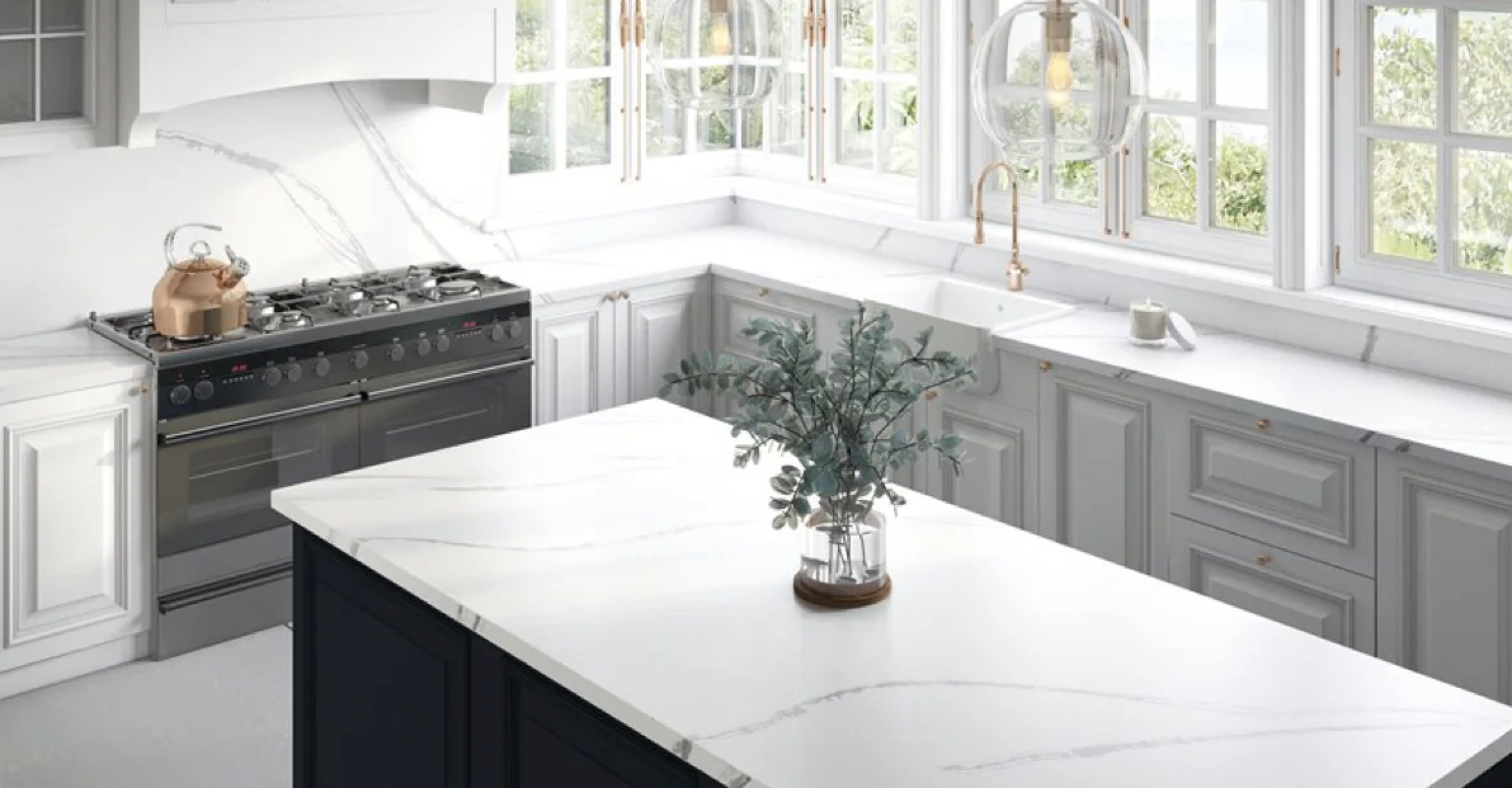
As the heart of the home, the kitchen is where we gather with friends and family to cook, eat, celebrate, and socialize. Spending so much time in the kitchen also means it can quickly become messy and disorganized. Fortunately, you can design your space so that it’s easy to find what you need — and return items to their rightful places. Read today’s featured article of the week for ways to create a tidy, clutter-free kitchen.
1. Create Adequate Storage Space
Open-concept kitchens, which open up to the main living and dining spaces, are popular in many new and renovated kitchens. When considering removing walls in your kitchen, keep in mind that you’ll also be eliminating storage space. Be sure there’s adequate storage elsewhere for all of your kitchen items and food.
2. Think About Island Storage
Many of our clients prefer generous-sized kitchen islands with bar seating because they entertain frequently and enjoy chatting with guests while preparing food. That means they may have to move bar stools to access island storage, depending on the design, which can be cumbersome.
Consider where your bar stools will be if you plan on incorporating storage into an island with lots of seating. Or try to store infrequently used items in the cabinets where there will be seating. (Also consider if your kitchen has the square footage necessary to accommodate an expansive island. In some cases, a large island can impede traffic flow.)
3. Opt for Large Drawers Instead of Lower Cabinets
I recommend using large drawers beneath countertops instead of conventional lower cabinets with shelves. I like this option because access is so much easier. With drawers, you won’t need to stoop down to search for something hiding in the back of a lower cabinet. Also, items can be more easily organized and stored. Keep in mind that drawers are more expensive than cabinets because of the additional internal hardware. Depending on your budget, the added functionality may be worth the splurge.
4. Reconsider Open Shelving
As a professional organizer, I recommend investing in traditional upper cabinets with doors for most of your upper storage. Unless everyone in your family is extremely organized, open shelves can quickly become cluttered and messy. Also, the items on shelves can become magnets for dust, grime and grease from cooking oil.
5. Choose Solid Doors for Upper Cabinets
Glass-front cabinets can be tempting, especially if you have beautiful glasses or dinnerware you want to display. However, cabinets can easily look cluttered if everything isn’t organized. If you love this look, perhaps consider installing only a few glass-front cabinets to display standout decor or kitchen items that aren’t used frequently.
6. Place Your Dishwasher for Easy Access to Storage
In most kitchens, the dishwasher is conveniently located next to the sink to simplify loading. When laying out your space, also think about the ease of unloading clean dishes and flatware. Consider where you’ll be standing when the dishwasher door is open and how easily you’ll be able to access drawers and storage.
Since emptying the dishwasher is a frequent task, convenient access to storage should be a priority. I have seen several kitchens where an open dishwasher door blocks access to storage for dinnerware and flatware. Other kitchen layouts require walking across the room to put away dishes. Also, make sure there’s plenty of space to stand at the sink when loading the dishwasher.
There are so many decisions to make when remodeling a kitchen. I recommend selecting a pro team that listens and collaborates with you during the design process so all of your needs are addressed. An experienced team should be able to create a new kitchen that is both beautiful and functional.
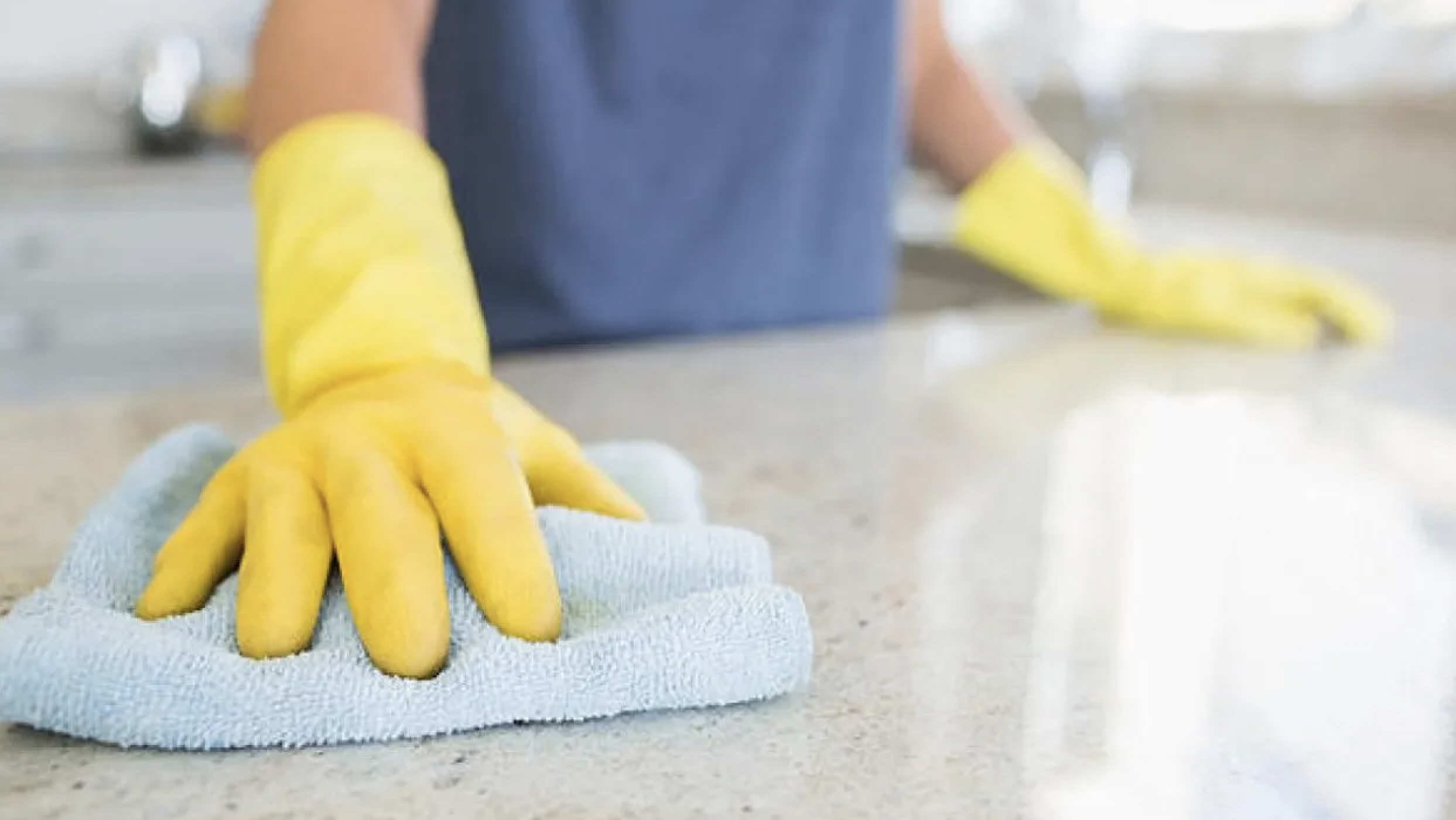
Quartz countertops are a beautiful and popular choice for many kitchens and bathrooms. They are durable and easy to care for, but they do require some special attention to keep them looking their best.
Do you have quartz countertops in your kitchen that you need to clean? If so, here are six tips to help you maintain clean quartz countertops:
Quartz is a non-porous material, so spills won’t penetrate the surface and cause stains. However, if they’re not wiped up quickly, they can still leave behind a residue that’s difficult to remove. So, as soon as something is spilled on your quartz countertop, wipe it up with a damp cloth.
Quartz is a durable material, but it’s not indestructible. Harsh cleansers can damage the surface, so it’s best to stick to milder products. You can use a gentle all-purpose cleaner or make your own by mixing equal parts of water and vinegar.
Scrubbers with abrasive surfaces, like steel wool or scouring pads, can scratch the surface of your quartz countertop. This will leave your countertop looking worn and ugly! So, when you’re cleaning, stick to soft cloths or non-abrasive scrubbers.
Harsh chemicals, like bleach, can damage the surface of your quartz countertop. So, it’s best to avoid using them altogether. If you must use a chemical cleaner, make sure to rinse the surface thoroughly afterward. Also, it is a smart idea to test spot an area first to make sure the chemical won’t damage the surface too much, if at all.
While quartz is a heat-resistant material, it can still be damaged by extreme heat. It’s okay to put warm items on it, like a hot cup of coffee. However, if you’re planning to place your pot on it right after making food, use caution. If possible, use a trivet or hot pad to protect the surface, and then place the pot or any other extremely hot item on it. This way, the countertop is saved from the high heat that can cause damage.
Cutting directly on the surface of your quartz countertop can damage it. So, it’s best to use a cutting board when preparing food. This also applies to essentially any other countertop material if you want to keep it in pristine condition. However, if you do accidentally cut on the surface, wipe up the area with a damp cloth to remove any debris.
Stay connected with all the latest trends in Kitchen & Bath! Sign up for our FREE Granite Buyers Club